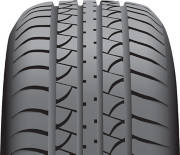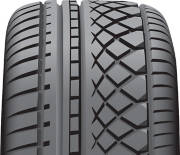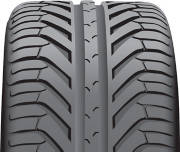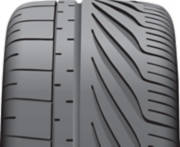We think it’s best to start at the beginning (this isn’t a Tarantino movie, after all!). First, let’s talk about the most common tread patterns. Used on the entire array of tire types and purposes, the four most common tread designs are symmetrical, asymmetrical, directional, and asymmetrical & directional.
Symmetrical Tread

The most common tire tread pattern out there, a symmetrical tread pattern is a tire design where the inner and outer tread blocks feature the same pattern.
Symmetrical tires can be rotated to any position on the vehicle, which helps prevent uneven treadwear. Some symmetrical tires have different sidewall options, including whitewall, blackwall and raised white letters. This gives you the option to choose how your tires look, depending on which style of sidewall you display!
Asymmetrical Tread
As you can see in the image to the right, an asymmetrical tread pattern has different features on the inner and outer tread areas.
Asymmetrical tread patterns use two design types to provide multiple benefits. Typically, one section of tread will provide all-season capabilities, while other sections provide a quiet ride and handling.
While most asymmetric tires only utilize different tread designs on the inner and outer area, some competition-level tires use different rubber compounds on each side to provide enhanced grip and handling.
Asymmetrical tires come with mounting instructions molded onto the sidewall to ensure they are installed the correct way. For example it may read "Mount This Side Out."

Directional Tread

Just like the name indicates, directional tires use a tread pattern that's angled to point in one direction.
Often referred to as a V-shaped tread pattern, directional tires are typically powerful in wet weather because the angled tread blocks push away water from the contact patch more effectively.
Directional tires cannot be rotated from one side of the vehicle to the other side without a complicated mounting/dismounting process. This can potentially lead to more road noise as these tires wear.
Like asymmetric tires, directional tires come with explicit mounting instructions so that they can be mounted the proper way. Directional tires should be mounted with two going left (driver's side) and two going right (passenger side).
Asymmetrical and Directional Tread
Asymmetrical and directional tires are a combination of the two tread designs.
This tread pattern is very uncommon and is typically found in the ultra-high performance category. These tires can only be mounted one way and will be designated as either right side or left side tires for your vehicle.
As long as the tires are not staggered, they can be rotated front to back. If the vehicle has staggered fitment the tires must remain in the same position for the duration of their life.
This can mean a significantly shorter tread life than the other tire tread pattern types mentioned here. But because they're largely used for ultra-high performance or even competition purposes, tread life usually isn't the main concern!

There you have it! That’s our rundown of the four most common tire tread patterns. This should help make it easier for you to determine which tires are the best choice for you!
Use Treadwell, our tire buying guide, to get the same tire recommendations our employees would make in-store. Then book your appointment at the same time. We’ll take care of the rest!
If you have any questions or require any assistance, stop by any of our America's Tire locations and we'll get you taken care of!
